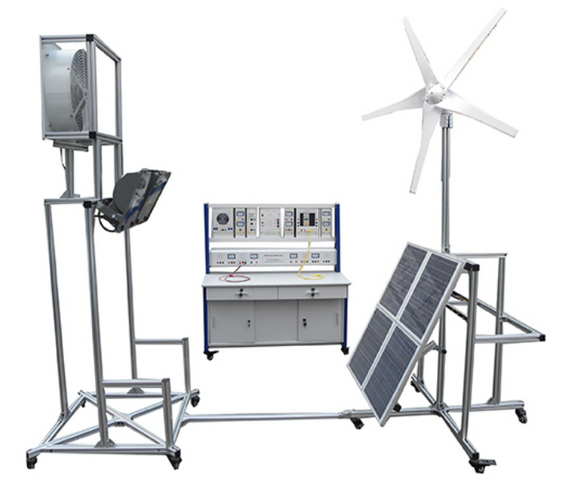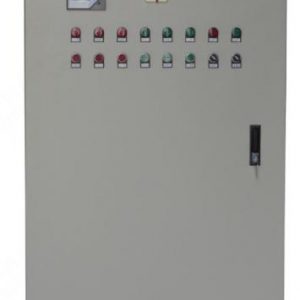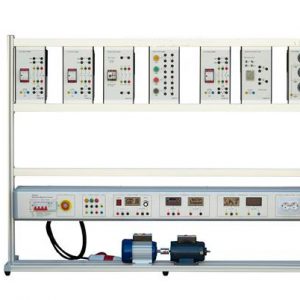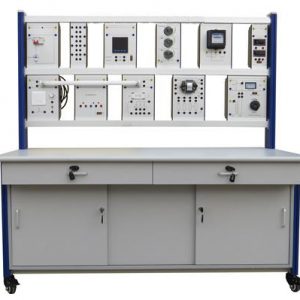
Laboratory Stand “Single Phase and 3-Phase Stabilizer”
January 18, 2025
Laboratory Stand “Automatic Tracking Motion Control”
January 18, 2025Laboratory Stand “Wind and Solar Renewable Energy”
$7,500.00
Simulates the generation of electricity using wind and solar power. Enables students to study the integration and operation of hybrid renewable energy systems.
Product Overview
The Laboratory Stand “Wind and Solar Renewable Energy” is a comprehensive training system designed to simulate wind and solar electricity generation processes. This innovative platform enables students to gain hands-on experience in learning about renewable energy systems, including wind and solar power generation, control mechanisms, and inverter systems. It is ideally suited for engineering universities, training institutes, and technical schools, fostering practical skills in renewable energy technologies.
The stand features an aluminum column structure with integrated measurement meters, universal wheels for easy mobility, and a safety protection system. It allows students to perform various experimental circuits and combine components into different configurations for diverse experiments and training content.
Technical Parameters
- Work Condition:
- Temperature: -10~+40℃
- Humidity: ≤80%
- Environment Air: No corrosive air, no fuel air, no large quantity of conductive dust
- Power Specifications:
- Consumption: ≤5000W
- Work Power: AC220V±5%, DC24V
- Supply Power: Single-phase three wires AC220V±5%, 50Hz
- Work Mode: Continuous
- Relative Humidity: 35~85% RH (Non-condensate)
- Сan be equipped with transport rollers
System Introduction
The system is divided into four main parts: Wind Electricity Generation System , Photovoltaic Power Generation System , Control System , and Inverter System .
Wind Electricity Generation System
- Consists of a fan, generator, and battery.
- Simulated Wind Generator: Uses a horizontal axis magnet synchronous generator driven by a fan. Adjust the fan position to change wind strength and direction, testing generator performance under varying conditions.
Photovoltaic Power Generation System
- Consists of a light source, photovoltaic cell plate, and battery.
- Simulated Solar System: Features four 30W solar energy boards that can be connected in series or parallel based on system requirements. The simulation set includes two metal halides, adjustable relative to the photovoltaic panel to simulate solar light position and demonstrate functionality.
Control System
- Includes a wind and solar complementary controller housed in a hanging box.
- Equipped with an industrial-type charger controller to manage charging from both wind and photovoltaic generators.
- Features an LCD display board for checking system technical parameters and enabling self-settings, preventing overcharge and overcurrent.
Inverter System
- Inverter Hanging Box: Adopts a 12V/24V intelligent recognition frequency inverter with output voltage AC220V.
- Continuous Work Power: 600W, Peak Work Power: 1000W, Efficiency >90%.
- Includes a low-voltage automatic alarm function for enhanced safety.
Functional Features
- Transparent Design:
- Enables clear observation of internal structures and operational processes, fostering a deeper understanding of renewable energy systems.
- Safety-Oriented Design:
- Equipped with a safety protection system, short-circuit protection, and low-voltage alarms to ensure secure operation during experiments.
- Interactive Learning Platform:
- Allows students to combine components into different circuits and conduct experiments on wind and solar power generation, control systems, and inverters.
- Compact and Mobile Structure:
- Features universal wheels with brakes at the bottom of the training workbench for easy movement and fixation as needed.
- Durable Construction:
- The desktop is made of 25mm thick high-density board with a high-temperature-resistant surface, ensuring long-term usability.
- Comprehensive Storage:
- Includes three doors and two drawers for organized storage of tools and accessories, enhancing functionality and aesthetics.
Training Projects
- Battery Feature Test:
- Measure electrical technical parameters and test battery connections in series and parallel.
- Charge Controller Experiments:
- Connect inverse protection experiment.
- Controller protection on battery overcharge experiment.
- Controller protection on battery over-discharging experiment.
- Anti-charge experiment.
- Simulated Wind Electricity Generation System Experiment:
- Study the simulated wind electricity generation process using a horizontal axis magnet synchronous generator.
- Wind Energy Charging Control Experiment:
- Investigate the principles of wind energy charging control and its impact on battery performance.
- Generator Work Power Test Experiment:
- Measure and analyze the work power of the generator under varying wind conditions.
- Photovoltaic Battery Open Circuit Voltage Test Experiment:
- Test the open circuit voltage of photovoltaic batteries under different illumination levels.
- Photovoltaic Battery Short Circuit Current Test Experiment:
- Measure the short circuit current of photovoltaic batteries to understand their electrical characteristics.
- Photovoltaic Battery Work Power Test Experiment:
- Analyze the work power of photovoltaic batteries under varying conditions.
- Photovoltaic Battery Maximum Test Experiment Under Different Illumination:
- Study the maximum output of photovoltaic batteries under different lighting conditions.
- Photovoltaic Battery Output Feature Experiment:
- Investigate the output characteristics of photovoltaic batteries, including voltage and current variations.
- Photovoltaic Battery Charging Control Principle Experiment:
- Understand the principles of photovoltaic battery charging control and its integration with the control system.
- Photovoltaic Battery Anti-Charging Experiment:
- Study the anti-charging mechanism of photovoltaic batteries to prevent reverse current flow.
- Photovoltaic Battery Connection in Series and Parallel Experiment:
- Experiment with connecting photovoltaic batteries in series and parallel configurations.
- Inverter Basic Principle Experiment:
- Learn the basic principles of inverters and their role in converting DC to AC power.
- Simple Inverter Output Waveform Test Experiment:
- Test and analyze the output waveform of the inverter to ensure proper functionality.
- Inverter Power Drive AC Load Experiment:
- Use the inverter to drive AC loads such as incandescent bulbs, energy-saving lights, and axle fans.
- Wind and Solar Generator Complementary Experiment:
Combine wind and solar power generation systems to study their complementary operation and efficiency improvements.
Educational Benefits
- Hands-On Experience: Students gain practical experience by interacting directly with real-world components of wind and solar power generation systems.
- Comprehensive Coverage: The stand covers all essential aspects of renewable energy systems, including wind and solar power generation, control systems, and inverters.
- Visualization Capabilities: Transparent design and real-time meter displays provide clear insights into system behavior and operational processes.
- Safety-Oriented Design: Equipped with safety features such as short-circuit protection and low-voltage alarms to ensure secure operation during experiments.
Conclusion
The Laboratory Stand “Wind and Solar Renewable Energy” is a cutting-edge educational tool that combines real-world components with advanced simulation capabilities. Its robust design, interactive features, and wide range of functionalities make it an indispensable solution for teaching and training in modern renewable energy technologies and sustainable engineering practices.




